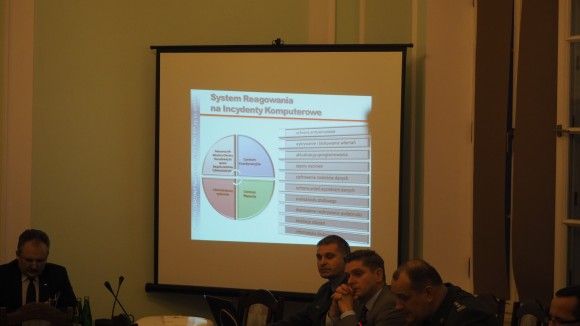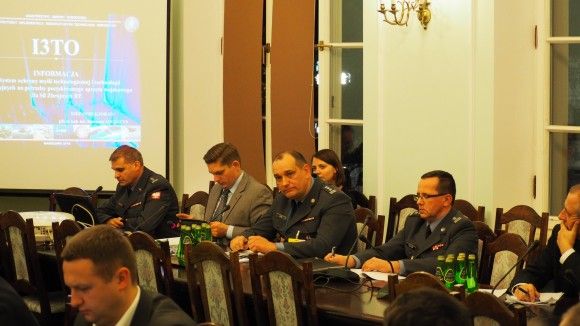“Third Unveiling of Kryl” in Kielce
During the MSPO Defence Expo in Kielce, Huta Stalowa Wola is showcasing a prototype of the Kryl 155 mm self-propelled howitzer. Following a series of tests, the vehicle underwent minor modifications and the series production example may be presented to the Army at the beginning of 2019.
The Agreement concerning the development works related to a light wheeled self-propelled 155 mm howitzer has been concluded at the end of December 2011, with guaranteed financing of PLN 28.2 million. Huta Stalowa Wola became the entity that is to implement the programme, at the time the said facility was determined to finalize the first phase of the Krab programme restarted back in 2008, concerning a tracked SPH.
As we know, despite the well known problems related to the chassis delivered by the Gliwice-based armoured platforms factory, at the end of November 2012 the Army has received, in order to carry out operational and military tests, the first fire element consisting of eight Krab howitzers. Ultimately, the Krab SPH has been based on the new K9 chassis. Just recently, the Polish Army has received the first equipment set for the Squadron Fire Module unit (DMO). At the moment the Regina programme is being implemented effectively (in 2016 an agreement has been signed concerning the equipment for another four squadrons), meanwhile the Polish Ministry of Defence remains interested in acquiring wheeled, lighter and cheaper Kryl systems, that also exhibit a higher degree of mobility. The long range artillery also remains one of the priorities within the Strategic Defence Review.
Within the first phase of the Kryl SPH programme, cooperation with the Nexter company was being considered, with the Polish solution being based on the artillery component of the Caesar howitzer. Following the technical analysis the competitive Israeli solution, the ATMOS 2000 howitzer offered by Elbit, has been selected as the way to go. Both solutions, technically similar, assumed that the cannon would be loaded manually and that the crew would remain in the open space, when laying down the artillery fire.
The Israeli offer has got the Polish partners convinced with the following arguments: the Israeli claimed that business offer was more flexible, and that the ATMOS system would provide the user with a wider angle of fire azimuthally. Moreover, the supplier, according to the HSW facility, was more open towards potential technology transfer, assuming that Poland would not procure, alongside the artillery portion of the system, the chassis.
It was assumed, despite the negative experiences related to the Krab’s tracked platform, that the chassis would be developed from a scratch, domestically.
For the HSW S.A. facility the above was significant also due to the fact that in April 2012 the company has taken over the Jelcz-Laskowice factory, and had both the capital, as well as the concept to reinforce the Jelcz-Komponenty company and its design and technology background. HSW guaranteed that a chassis would be developed for Kryl that would meet the basic requirement defined by the Army, as it was required that the SPH should be light enough to be transported onboard of a plane. Kryl was to fit onto the C-130 Hercules aircraft (in 2012 the deliveries of this aircraft for the 33rd Airlift Base were coming to an end, with 5 contracted airframes being stationed there).
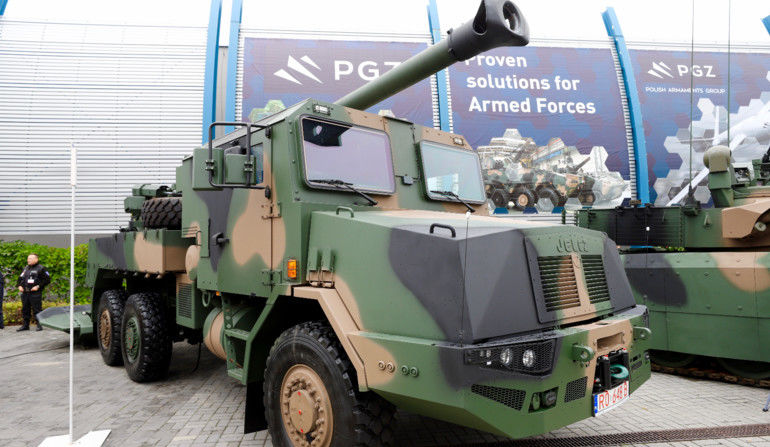
This, from the very beginning, was creating relevant limitations concerning the weight (airlifter’s payload capacity) and dimensions (loading space, access) of the developed platform. The military, at the time deeply involved in the foreign deployments, stated that the ability to be transported by Hercules would be an absolute, categorical and final condition.
Read More: “Kryl” Going Through a Renaissance?
The Polish design was to be similar, within that respect, to the French Caesar solution. In practical terms it turned out that C-130 aircraft imposes a number of design limitations concerning this class of artillery assets.
The above means that it is difficult to understand that the designers did not get themselves inspired with the Ceasar howitzer solutions, indicated by the Polish military. Some solutions were imposed by the design logic. Moreover, the prototype also featured a plastic engine cover, rearview mirrors of a specific type and a single cabin door.
The latter solution is good, as space within the cabin is not taken by the tunnel covering the engine block. Rapid manning of the battle-stations is not a problem, delaying the attainment of combat readiness once fire-mission orders are received.
For the HSW, Jelcz and Elbit designers, as well as for the collaborating engineers of several Universities, the requirement defined by the military was a serious challenge. The most difficult challenge was to keep the platform’s weight below 19 tonnes for airlift (with the combat weight, including the crew, ammunition and fuel, at 21 tonnes).
It was also required that entirely new design layout was created for the wheeled platform with a nose-layout cabin with the engine protruded in front of the front axle and lowered roof. Moreover, the platform also featured a number of innovative solutions, never before used by the Polish industry, within the scope of materials, design, suspension layout and so on.
The Israeli partner of the programme was also forced to modify the ATMOS 2000 system, including the intermediary frame, to diminish the weight of the platform by around 500 kilograms. Despite the aforesaid problems, the tempo of work was satisfactory: in July 2014, a prototype of the chassis, designated as Type 663, and expected to be used with the Kryl system, was presented. In mid-August HSW received the Israeli artillery system, and the Kryl platform created out of the aforesaid assemblies was showcased at the MSPO event in September, sparking a lot of interest.
According to the plans made back in 2012, the Kryl development work was to be finalized until the end of December 2015. Later the aforesaid assumptions were adjusted, with the deadline postponed to the final quarter of the year 2018, which was to make it possible to begin deliveries of 7 Squadron Fire Modules (DMO) in 2019, with 24 howitzers in each of the units. Ultimately, when the Technical Modernization Plan was being updated, this phase of work has been scheduled to be finalized on 27th August...2020. The programme and the course of the works have been described by us earlier.
Despite the lack of formal basis, in a form of a research programme co-arranged with the military, the preliminary tests were carried out independently by HSW S.A. It was assumed that in the situation in which a “driveable and shooting” artillery product exists, it shall be perfected to shorten the time required to introduce it into production, should the Army ultimately express its interest in the said system.
Not only did the preliminary test programme carried out by the HSW facility on its own, covered by the facility’s own funds, but also in collaboration with specialized research institutes, include traction tests that verified a variety of chassis design solutions, but the initiative also concerned artillery tests, also involving a maximum propelling charge load live-fire test at the Slovak Zagorje range.
All of the aforesaid research was aimed at refinement of the design, and at diagnosing and effectively eliminating the “infancy” problems. They shall not emerge at the stage of the formal qualification test programme.
The first step that was made to perfect the platform’s design was the redesign process, concerning the engine hood and the front bumper. The requirement to do this emerged during the field tests, as the front axle of the vehicle had to have more load imposed on it, for the purpose of refining the handling capabilities of the platform. On that occasion the engine compartment was also fitted with armour-plating, which has enhanced the level of ballistic protection for the powerpack, also making it more resistant to any fragmentation e.g. of artillery rounds.
In mid-August Kryl was returned to HSW S.A, following yet another lifting resulting from the experience gathered during the further field tests, and from the analysis of the assessments, comments, and public sphere opinions in existence. In this form, the howitzer was presented during this year’s MSPO 2017 event.
The observers will, undoubtedly, notice the redesigned front section of the Jelcz vehicle. The bumper was redesigned to enhance the vehicle angle of attack, also improving its offroad capabilities. The new bumper also features a winch. Its parameters have not been disclosed by the manufacturer, but the specification has been summed up with a statement suggesting that the system allows to pull a vehicle out of rough terrain, with the pulled platform weighing no less than the fully loaded Kryl sph.
The above statement may suggest that the Kryl howitzer, even though such requirement was not created by the military, is capable of getting itself out of rough terrain. But this is not the end, as the vehicle should also be able to recover other howitzers of the same type, ammunition or engineering, or even the command platforms included in the Kryl Squadron, with the winch allowing for recovery of any other vehicle weighing around 20 tonnes.
The aforesaid change also made the weight distribution better, with more mass placed on the steered axle. Moreover, the said parameter has also been enhanced as the designers have resigned from using the additional, fourth axle. The said axle was created to facilitate the process of loading the howitzer on the C-130 aircraft.
When the Polish Ministry of Defence has officially resigned from the requirement of providing the Kryl system with airlift suitability, tailored to the Hercules aircraft, the solution became irrelevant and redundant. Getting rid of the load placed behind the third axle enhanced the weight distribution even further. Thanks to the above, the driving differences offroad, between a fully loaded vehicle, and a vehicle without the ammunition, were also diminished.
The side ammunition storage placed between the first and the second axle house 18 sets of rounds and propelling charges, weighing almost 1500 kilograms. There is a design reserve that would allow for increasing the ammunition load. The field tests carried out so far confirm the fact that Kryl, fully manned, going over the obstacles on the test tracks used to test the Rak self-propelled mortar and the AWD command vehicles based on the Rosomak platform, was carrying out all of the movement without a need of using the offroad gears. The only change required for the Kryl howitzer, in comparison with the road configuration, was to slightly lower the tyre air pressure.
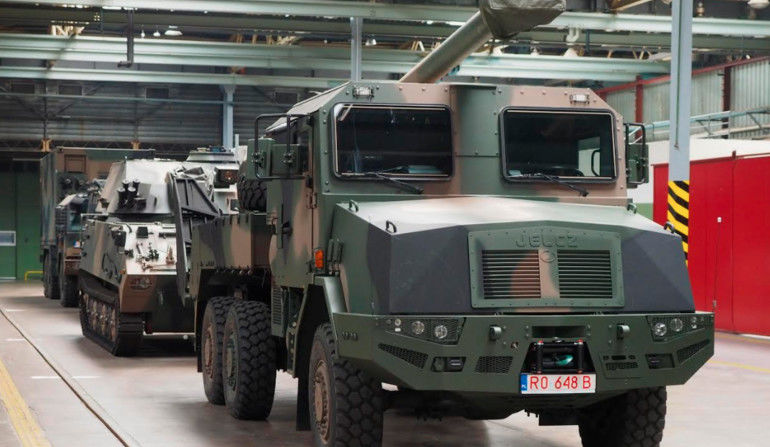
The most important change that is noticeable right away is seen in replacement of the front lighting system, criticized earlier. The presented Kryl vehicle has received a set of modern, efficient lens-burner headlamps. They provide a higher intensity of light and make the howitzer look much more modern.
The HSW S.A. experts also responded to the questions related to the ammunition loading process: “Within a few days we are able, and the Polish Ministry of Defence knows our abilities within that scope, to introduce changes in the fire control system that would simplify the ammunition loading process, shortening its duration and increasing the rate of fire.” However, the engineers do not promise that a complete autoloader would be applied in case of the Kryl system, as this would be technically difficult, requiring fundamental design changes. They suggest that solutions similar to the ones used in case of the Archer or Nora, or even the Eva systems are impossible to be applied - these platforms were originally designed with automatic loading in mind. New information has also been published concerning new types of ammunition for the Kryl howitzer. HSW S.A. confirms the fact that it has received a serious offer from the ammunition manufacturers who remain ready to deliver rounds with a range of 56 kilometers for the Kryl system. The range declared at the moment is equal to around 40 kilometers.
Here we are referring to base-bleed or rocket-assisted rounds. HSW does not consider conclusion of ammunition memorandum to be a problem, however a problematic issue may emerge if a test programme concerning such rounds would have to be carried out, due to a lack of a proper range available. Nobody in Europe has carried out such tests so far.
Rheinmetall has been developing its extended range ammunition by testing it in South Africa. The parties, at the moment, are working on a memorandum concerning this issue. HSW S.A. is interested in the said memorandum as several foreign buyers remain highly interested in procuring the Kryl howitzer. One of the potential buyers, based outside Europe, expects that demonstration of ability to conduct fire missions at distances of 50 km+ is performed as soon as possible.
Other potential customers based in Europe view the Kryl howitzer as a way to acquire a self-propelled, highly mobile and NATO-compliant artillery platform at a relatively low price. The cost ratio between procurements of Kryl and Krab systems is estimated at the Polish Ministry of Defence as 1:3. This is quite important for the states that have limited amount of money at their disposal, or that are using a low quality road network in difficult terrain. Slovenia, Montenegro or Macedonia may be included among the aforesaid countries.
Kryl’s potential also remains relevant for the Polish Army. The heavy brigades, as we know it now, are going to receive the Regina modules with the tracked Krab SPHs. Gvozdika era is passing by, and this cannot be changed by any of the recent upgrade programmes.
Modernization of the model 77 Dana howitzer, also expected to happen as it was included in the Strategic Defence Review, would not mean that gradual increase of capabilities of the Polish artillery would occur. The upgrade may allow the army to keep the Dana systems in service, or to insignificantly expand their combat capabilities, nonetheless one cannot expect the range to be expanded, as Danas utilize the old “Soviet” 152 mm rounds, not the NATO standard 155 mm ammunition.
Krab has an effective range of 40 kilometres, same applies to Kryl, however, according to the information mentioned earlier, rocket assisted or base-bleed rounds may be used to attack targets at a distance of 56 kilometres or beyond. We do not know though, whether the extended range ammunition could be used with the Krab howitzers.
We must leave aside the issue of effective operational use of such potential, entailed by such ammo, which requires a proper array of reconnaissance and target designation assets, capable of being operated behind the enemy lines, at the distance corresponding at least with the effective range of fire of the two aforesaid systems. It may be assumed that the problem may be solved through development of the currently utilized UAV-based reconnaissance systems, including the UAVs that are to be acquired in the future.
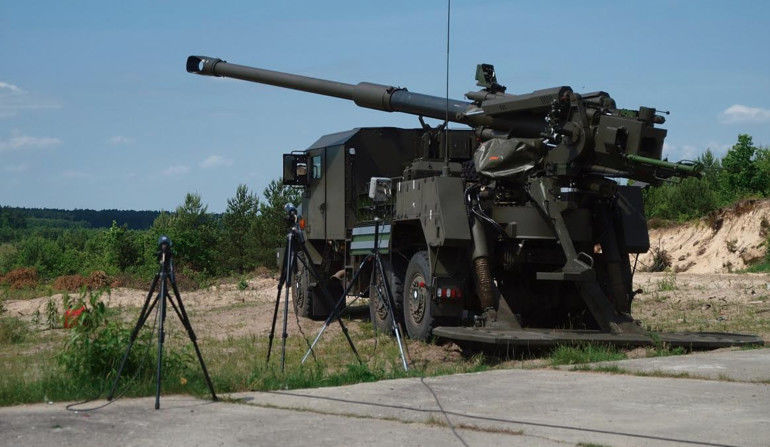
The official premiere of the Kryl system took place three years ago, however the implementation process has been hampered by legal and formal procedures. Even though the system has been available since 2014, the stage of developing the design assumptions is planned to be formally finalized in 2017. Now the formal arrangements concerning the configuration of the Kryl modules are being refined in collaboration with the National Centre for Research and Development. The aforesaid arrangements are to take on a form of an annex to the agreement that created the relationship between the HSW S.A. company and the National Centre for Research and Development, concluded on 28th December 2011.
The representatives of the HSW S.A. company assure that Kryl, along with the series production documentation, may be delivered in 2019, if the Polish Ministry of Defence expresses its interest in the project and if no need emerges to change the system’s design significantly.
At the moment the Armament Inspectorate has received a document package concerning the Kryl howitzer, including the most important element: the conceptual design. Theoretically this should make it possible to approve the relevant general project assumptions by the end of this year, as well as to issue an approval concerning the programme of initial and qualification tests.
We are, until the end of September 2018, able to finalize the preparation of series manufacturing of the Kryl SPH and to leave the documentation for series production for the Kryl SPH at disposal of the MoD until the end of January 2019.
The prolonged work on the Kryl system may also have an impact on another programme that is fairly important for the Polish Armed forces: the WR-300 Homar rocket artillery system development process. A relevant agreement concerning the above solution is to be concluded soon. According to the assumptions adopted when the Jelcz 663 platform was being designed, the first platform of this type designed for military applications was to be used both within the Kryl SPH project, as well as within the WR-300 Homar programme.
Now, when the formal test programme concerning the Kryl howitzer has only begun, with the finalization expected to happen next year, it remains doubtful whether the chassis 663 may also be considered in the Homar programme. As for now, the schedule in place, included in the Technical Modernization Plan that has been modified in April and confirmed within the Strategic Defence Review, assumes that delivery of three Homar squadrons would take place in 2019. It is possible that there will be no option of basing the system on the Kryl chassis that has not yet gone through the formal test programme.
HSW S.A., PGZ, as well as Lockheed Martin, the American entity involved in the Homar programme, should all have an alternative solution prepared. One of the Jelcz trucks that is being already operated by the Polish Armed Forces is to be used for that purpose, as all signs seem to suggest.
Jerzy Reszczyński

